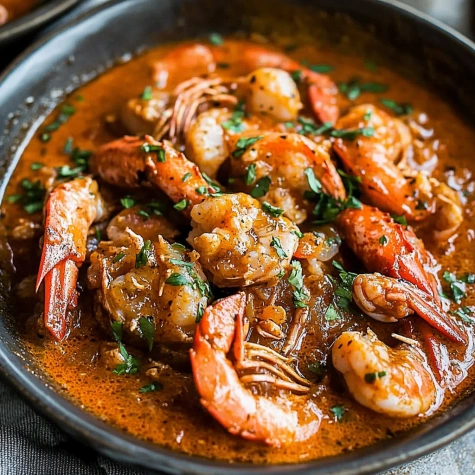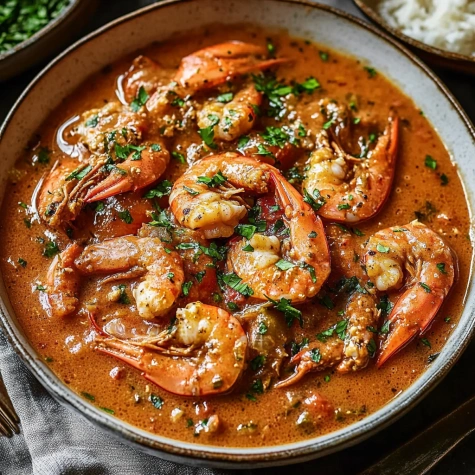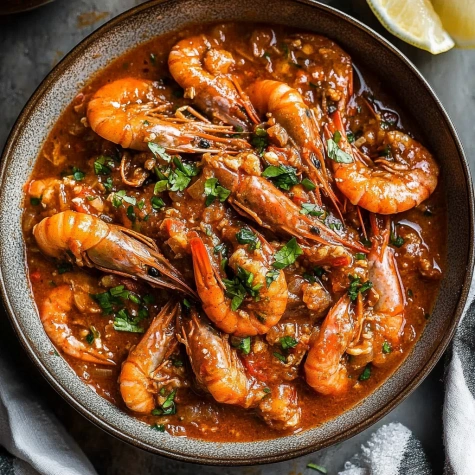 Pin it
Pin it
This crawfish étouffée celebrates the rich traditions of Louisiana cooking, transforming simple ingredients into a deeply satisfying dish that tastes like home. The secret lies in a properly developed roux that creates a silky sauce perfectly coating plump crawfish tails served over rice.
I first made this dish after returning from a trip to New Orleans, trying to recapture those magical flavors of the French Quarter. It has since become my go-to recipe whenever I want to impress dinner guests with something that feels both special and comforting.
Ingredients
- Yellow onion: Forms the foundation of flavor in the holy trinity of Cajun cooking
- Green bell pepper: Adds a subtle sweetness and authentic Cajun character
- Celery: Provides texture and aromatic qualities essential to proper étouffée
- Garlic cloves: Add depth and warmth when cooked slowly in butter
- All-purpose flour: Combines with butter to create the crucial roux thickener
- Butter: Creates richness and helps develop the nutty flavor in the roux
- Seafood broth: Provides the liquid foundation for your sauce
- Lobster flavor base: Intensifies the seafood essence throughout the dish
- Cajun seasoning: Brings authentic Louisiana spice profile
- Dried thyme: Adds earthy herbal notes traditional in Cajun cooking
- Black pepper: Contributes necessary heat without overwhelming
- Kosher salt: Enhances all flavors and balances the richness
- Cayenne pepper: Provides the distinctive Louisiana heat level
- Louisiana crawfish tails: The star ingredient with their sweet delicate flavor
- Green onions: Add fresh bite and color as a finishing touch
- Rice or grits: Serve as the perfect canvas for the flavorful sauce
Step-by-Step Instructions
- Sauté the Holy Trinity:
- Melt 3-4 tablespoons of butter in a large cast-iron skillet over medium heat until foaming subsides. Add the diced onion, chopped celery, and bell pepper along with the minced garlic. Cook for approximately 5 minutes, stirring occasionally until vegetables soften and become translucent. The onions should lose their raw bite but not brown. Remove this aromatic mixture and set aside.
- Create the Roux:
- Reduce heat to medium-low and add the remaining 8 tablespoons of butter to the pan. Once melted, gradually sprinkle in the flour while whisking continuously. Continue whisking without stopping for 10-15 minutes until the mixture transforms into a smooth peanut butter colored base. This slow cooking develops deep nutty flavors that define authentic étouffée. Watch carefully and reduce heat immediately if any burning occurs.
- Build the Sauce:
- Turn heat to its lowest setting. Very gradually pour in the seafood stock in a thin stream while whisking constantly to prevent lumps from forming. Return the cooked vegetables to the pan along with all seasonings and lobster base. Allow this mixture to simmer gently for 10 minutes, stirring occasionally until it reaches a velvety gravy consistency that coats the back of a spoon.
- Incorporate the Crawfish:
- Gently fold in the crawfish tails, being careful not to break them. Heat them through for just 3-4 minutes until warm. Avoid overcooking as crawfish can toughen quickly. Taste the sauce and adjust seasonings as needed, adding more salt, pepper or cayenne according to your preference.
- Serve and Garnish:
- Spoon generous portions of the crawfish étouffée over warm rice or creamy grits. Sprinkle freshly chopped green onions across the top for color and freshness. Place bottles of hot sauce on the table so each person can adjust the heat level to their liking.
 Pin it
Pin it
The first time I served this étouffée to my Louisiana-born neighbor, he closed his eyes after the first bite and said it transported him straight back to his grandmother's kitchen in Baton Rouge. That moment convinced me I had captured the authentic essence of this beloved Cajun classic.
Storing Leftovers
Crawfish étouffée improves with time as the flavors continue to develop. Store any leftovers in an airtight container in the refrigerator for up to three days. When reheating, do so gently over low heat, adding a splash of water or stock if the sauce has thickened too much. Avoid microwaving if possible as it can make the crawfish tough. The sauce will naturally separate when chilled but will recombine beautifully when warmed slowly with gentle stirring.
 Pin it
Pin it
Making Substitutions
While Louisiana crawfish create the most authentic flavor, you can substitute shrimp if crawfish are unavailable in your area. Simply peel and devein medium shrimp and add them at the same stage of cooking. Chicken stock can replace seafood stock in a pinch, though the seafood flavor will be less pronounced. For a gluten-free version, substitute rice flour for all-purpose flour when making the roux, though you may need to adjust the cooking time slightly as rice flour browns differently.
The Soul of Cajun Cooking
Étouffée comes from the French word "étouffer" meaning "to smother," referring to how the crawfish are smothered in the flavorful sauce. This dish represents the beautiful blend of French, African, and Southern influences that define Cajun cuisine. The technique of building flavor through a properly developed roux came from French culinary traditions, while the spice profile reflects Caribbean and African influences. In Louisiana, this dish often appears at family gatherings and celebrations, where it's served with plenty of French bread for sopping up the magnificent sauce.
Frequently Asked Questions
- → Can I substitute shrimp for the crawfish tails?
Yes, shrimp works excellently as a substitute for crawfish tails. Use the same amount (1 pound) of peeled and deveined shrimp, but reduce the cooking time to just 2-3 minutes as shrimp cook faster than crawfish. Add them at the final stage and cook just until they turn pink and opaque.
- → What is the Holy Trinity in Cajun cooking?
The Holy Trinity is the foundation of many Cajun dishes, consisting of equal parts onion, celery, and bell pepper. This aromatic base provides the essential flavor profile that defines Cajun cuisine. In this dish, the Holy Trinity is enhanced with garlic for additional depth of flavor.
- → What's the key to making a good roux?
The key to a good roux is patience and constant attention. Cook it over medium-low heat while whisking continuously to prevent burning. The peanut butter color indicated in the recipe provides the right balance of flavor without becoming bitter. Using a heavy-bottomed pan like cast iron helps distribute heat evenly for better results.
- → Can I make this dish ahead of time?
Yes, this dish actually improves with time as the flavors meld together. You can prepare it up to a day ahead and refrigerate it. When reheating, do so gently over low heat, adding a splash of seafood stock if the sauce becomes too thick. Add the crawfish tails just before serving to prevent them from becoming tough.
- → What can I serve with this Cajun crawfish dish?
While rice or grits are traditional, you can also serve this dish with crusty French bread for sopping up the sauce, a simple green salad with vinaigrette, steamed vegetables like green beans or asparagus, or corn maque choux (a traditional Cajun corn dish). For a complete Cajun experience, start with a small cup of gumbo as an appetizer.
- → What if I can't find lobster base?
If lobster base isn't available, you can substitute with additional seafood stock, clam juice, or even chicken stock with a splash of fish sauce. Another option is to use shrimp bouillon cubes or crab base. The goal is to enhance the seafood flavor of the dish, so use what's accessible while maintaining that oceanic profile.
